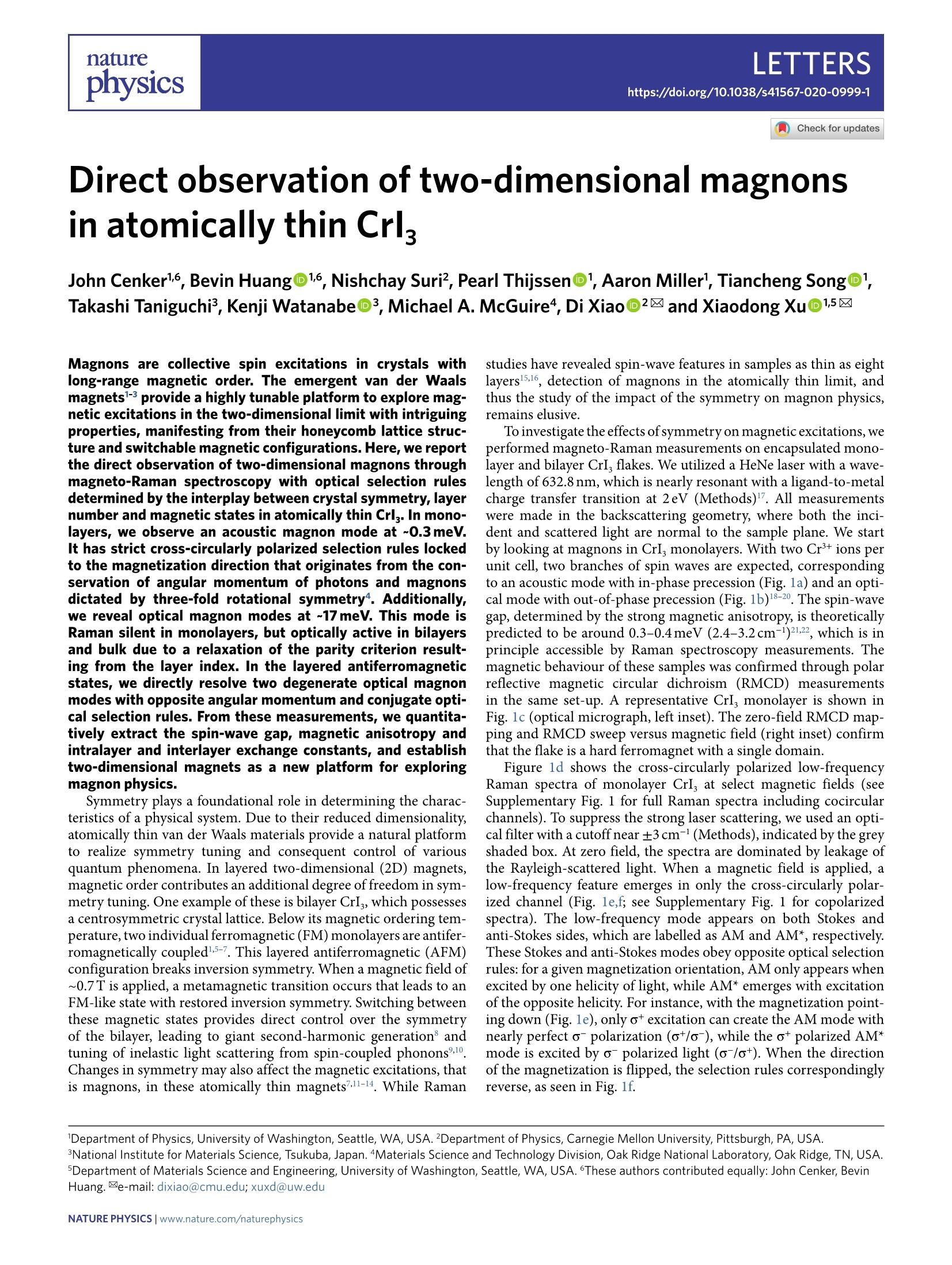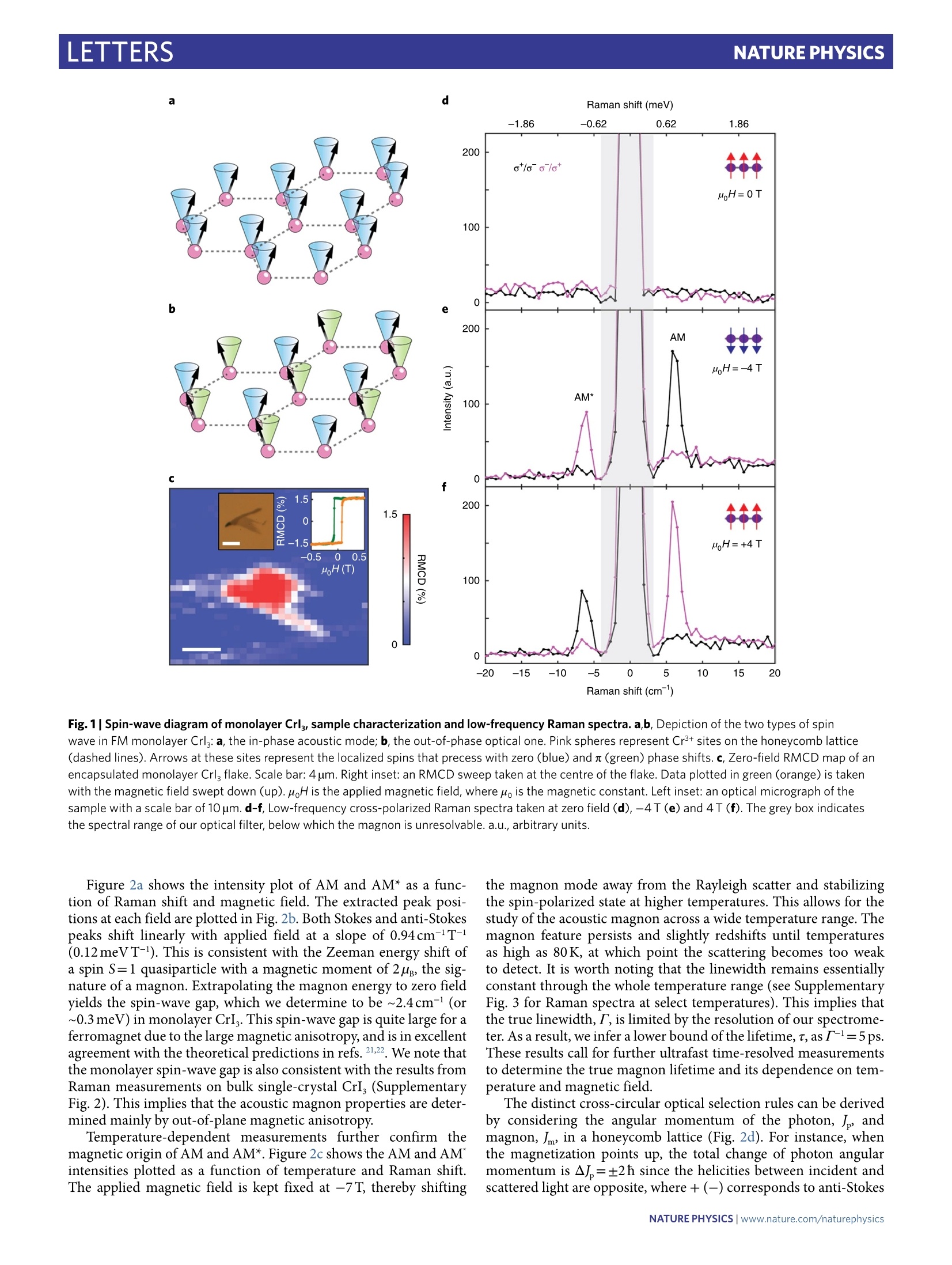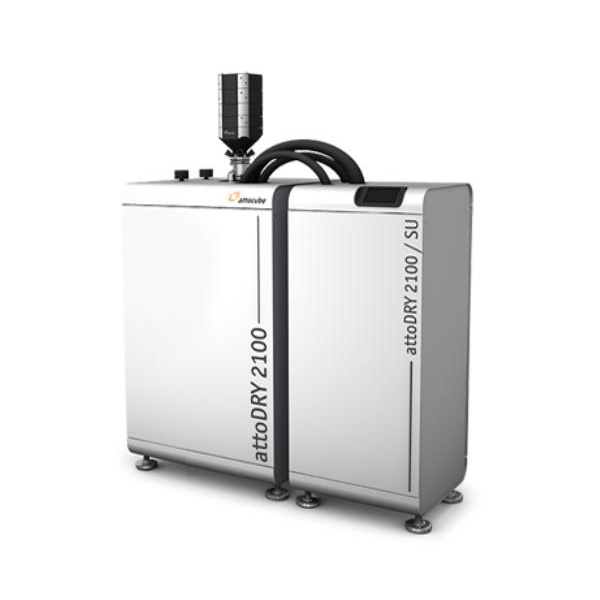方案详情文
智能文字提取功能测试中
LETTERShttps://doi.org/10.1038/s41567-020-0999-1naturephysics LETTERSNATURE PHYSICS Check for updates Direct observation of two-dimensional magnonsin atomically thin Crl, John Cenker16, Bevin Huang@16, Nishchay Suri, Pearl Thijssen@1, Aaron Miller, Tiancheng Song@1Takashi Taniguchi,Kenji WatanabeD3, Michael A. McGuire4, Di Xiao@2区 and Xiaodong XuD15区 Magnons are collective spin excitations in crystals withlong-range magnetic order. The emergent van der Waalsmagnets-3provide a highly tunable platform to explore mag-netic excitations in the two-dimensional limit with intriguingproperties, manifesting from their honeycomb lattice struc-ture and switchable magnetic configurations. Here, we reportthe direct observation of two-dimensional magnons throughmagneto-Raman spectroscopy with optical selection rulesdetermined by the interplay between crystal symmetry, layernumber and magnetic states in atomically thin Crlg. In mono-layers, we observe an acoustic magnon mode at ~0.3 meV.It has strict cross-circularly polarized selection rules lockedto the magnetization direction that originates from the con-servation of angular momentum of photons and magnonsdictated by three-fold rotational symmetry4. Additionally,we reveal optical magnon modes at ~17 meV. This mode isRaman silent in monolayers, but optically active in bilayersand bulk due to a relaxation of the parity criterion result-ing from the layer index. In the layered antiferromagneticstates, we directly resolve two degenerate optical magnonmodes with opposite angular momentum and conjugate opti-cal selection rules. From these measurements, we quantita-tively extract the spin-wave gap, magnetic anisotropy andintralayer and interlayer exchange constants, and establishtwo-dimensional magnets as a new platform for exploringmagnon physics. Symmetry plays a foundational role in determining the charac-teristics of a physical system. Due to their reduced dimensionality,atomically thin van der Waals materials provide a natural platformto realize symmetry tuning and consequent control of variousquantum phenomena. In layered two-dimensional (2D) magnets,magnetic order contributes an additional degree of freedom in sym-metry tuning. One example of these is bilayer CrI, which possessesa centrosymmetric crystal lattice. Below its magnetic ordering tem-perature, two individual ferromagnetic (FM) monolayers are antifer-romagnetically coupled1.5-7. This layered antiferromagnetic (AFM)configuration breaks inversion symmetry. When a magnetic field of~0.7T is applied, a metamagnetic transition occurs that leads to anFM-like state with restored inversion symmetry. Switching betweenthese magnetic states provides direct control over the symmetryof the bilayer, leading to giant second-harmonic generation andtuning of inelastic light scattering from spin-coupled phonons10.Changes in symmetry may also affect the magnetic excitations, thatis magnons, in these atomically thin magnets711-14. While Raman studies have revealed spin-wave features in samples as thin as eightlayers15,16, detection of magnons in the atomically thin limit, andthus the study of the impact of the symmetry on magnon physics,remains elusive. To investigate the effects of symmetry on magnetic excitations, weperformed magneto-Raman measurements on encapsulated mono-layer and bilayer CrI, flakes. We utilized a HeNe laser with a wave-length of 632.8 nm, which is nearly resonant with a ligand-to-metalcharge transfer transition at 2eV (Methods)1. All measurementswere made in the backscattering geometry, where both the inci-dent and scattered light are normal to the sample plane. We startby looking at magnons in CrI, monolayers. With two Crions perunit cell, two branches of spin waves are expected, correspondingto an acoustic mode with in-phase precession (Fig. 1a) and an opti-cal mode with out-of-phase precession (Fig. 1b)18-20. The spin-wavegap, determined by the strong magnetic anisotropy, is theoreticallypredicted to be around 0.3-0.4 meV (2.4-3.2 cm-)21,22, which is inprinciple accessible by Raman spectroscopy measurements. Themagnetic behaviour of these samples was confirmed through polarreflective magnetic circular dichroism (RMCD) measurementsin the same set-up. A representative CrI, monolayer is shown inFig. 1c (optical micrograph, left inset). The zero-field RMCD map-ping and RMCD sweep versus magnetic field (right inset) confirmthat the flake is a hard ferromagnet with a single domain. Figure el1d dshows the cross-circularly polarized low-frequencyRaman spectra of monolayer CrI, at select magnetic fields (seeSupplementary Fig. 1 for full Raman spectra including cocircularchannels). To suppress the strong laser scattering, we used an opti-cal filter with a cutoff near ±3 cm-l(Methods), indicated by the greyshaded box. At zero field, the spectra are dominated by leakage ofthe Rayleigh-scattered light. When a magnetic field is applied, alow-frequency feature emerges in only the cross-circularly polar-ized channel (Fig. 1e,f; see Supplementary Fig. 1 for copolarizedspectra). The low-frequency mode appears on both Stokes andanti-Stokes sides, which are labelled as AM and AM*, respectively.These Stokes and anti-Stokes modes obey opposite optical selectionrules: for a given magnetization orientation, AM only appears whenexcited by one helicity of light, while AM* emerges with excitationof the opposite helicity. For instance, with the magnetization point-ing down (Fig.1e), only ot excitation can create the AM mode withnearly perfect o polarization (o*/o-), while the ot polarized AM*mode is excited by o polarized light (o-/ot). When the directionof the magnetization is flipped, the selection rules correspondinglyreverse, as seen in Fig. 1f. ( 'Department of Physics, University of Washington, Seattle, WA, USA. 2Department of Physics, Carnegie Mellon University, Pittsburgh, PA, USA . 3National Institute for Materials Science, Tsukuba, Japan.4Materials Science an d Technology Division, Oak Ridge National Laboratory, Oak Ridge,TN,USA. 5Department of Materials Science and Engineering, University of Washington, S eattle, WA, U SA. 6These authors contributed equally: John Cenker, Bevin Huang. e -mail: dix i ao @c m u . e d u ; x ux d@u w.edu ) Raman shift (cm Fig. 1|Spin-wave diagram of monolayer Crl,, sample characterization and low-frequency Raman spectra. a,b, Depiction of the two types of spinwave in FM monolayer Crlg: a, the in-phase acoustic mode; b, the out-of-phase optical one. Pink spheres represent Cr+ sites on the honeycomb lattice(dashed lines). Arrows at these sites represent the localized spins that precess with zero (blue) andn(green) phase shifts. c, Zero-field RMCD map of anencapsulated monolayer Crl, flake. Scale bar: 4um. Right inset: an RMCD sweep taken at the centre of the flake. Data plotted in green (orange) is takenwith the magnetic field swept down(up).poH is the applied magnetic field, where po is the magnetic constant. Left inset: an optical micrograph of thesample with a scale bar of 10 um. d-f, Low-frequency cross-polarized Raman spectra taken at zero field (d),-4T(e)and 4T(f).The grey box indicatesthe spectral range of our optical filter, below which the magnon is unresolvable. a.u., arbitrary units. Figure 2a shows the intensity plot of AM and AM* as a func-tion of Raman shift and magnetic field. The extracted peak posi-tions at each field are plotted in Fig. 2b. Both Stokes and anti-Stokespeaks shift linearly with applied field at a slope of 0.94cm-T-1(0.12meVT-). This is consistent with the Zeeman energy shift ofa spin S=1 quasiparticle with a magnetic moment of 2 ug, the sig-nature of a magnon. Extrapolating the magnon energy to zero fieldyields the spin-wave gap, which we determine to be ~2.4cm- (or~0.3meV) in monolayer CrI. This spin-wave gap is quite large for aferromagnet due to the large magnetic anisotropy, and is in excellentagreement with the theoretical predictions in refs. 21,22. We note thatthe monolayer spin-wave gap is also consistent with the results fromRaman measurements on bulk single-crystal CrI, (SupplementaryFig.2). This implies that the acoustic magnon properties are deter-mined mainly by out-of-plane magnetic anisotropy. Temperature-dependent measurements further confirm themagnetic origin of AM and AM*. Figure 2c shows the AM and AMintensities plotted as a function of temperature and Raman shift.The applied magnetic field is kept fixed at -7T, thereby shifting the magnon mode away from the Rayleigh scatter and stabilizingthe spin-polarized state at higher temperatures. This allows for thestudy of the acoustic magnon across a wide temperature range. Themagnon feature persists and slightly redshifts until temperaturesas high as 80K, at which point the scattering becomes too weakto detect. It is worth noting that the linewidth remains essentiallyconstant through the whole temperature range (see SupplementaryFig. 3 for Raman spectra at select temperatures). This implies thatthe true linewidth,T, is limited by the resolution of our spectrome-ter. As a result, we infer a lower bound of the lifetime, t, as T-l=5ps.These results call for further ultrafast time-resolved measurementsto determine the true magnon lifetime and its dependence on tem-perature and magnetic field. The distinct cross-circular optical selection rules can be derivedby considering the angular momentum of the photon, Ip, andmagnon, Im, in a honeycomb lattice (Fig.2d). For instance, whenthe magnetization points up, the total change of photon angularmomentum is AJ =±2h since the helicities between incident andscattered light are opposite, where +(-) corresponds to anti-Stokes HoH(T) (Stokes) scattering from the magnon mode. The change of magnonangular momentum contributes AJ =±h. This leads to a totalchange of angular momentum that is AJ,+AJm=±3 h. In a systemwith continuous rotational symmetry,the conservation of angularmomentum would forbid such a process. However, in an analogueto the Umklapp process4.23, the three-fold symmetry of the honey-comb lattice in monolayer CrI, allows for discrete angular momen-tum conservation up to modulo 3h:AJ+AJ/h=0 (mod 3).Given that the total change of the angular momentum is a multipleof 3h, cross-circular selection rules are expected in monolayer CrI,.A group theory analysis yields the same conclusion (Methods). Wenote that for bulk single crystals (Supplementary Fig. 2) we observea relaxation of this selection rule. The magnon scattering is still pre-dominantly in the cross-circular channels, but substantial scatteringin the cocircular channels is also present. This deviation from theexpected selection rules could potentially originate from stackingfaults and highlights the intriguing physics afforded by studyingatomically thin samples with pristine crystal structures. Unlike the monolayer, bilayer CrI, hosts either an FM-likestate or a layered AFM state, depending on the applied magneticfield, below a critical temperature of 45 K. Figure 3a shows thelow-frequency Raman spectrum of a CrI, bilayer in an appliedfield of 6T. Since the magnetizations of the two layers are alignedin the same direction by the magnetic field, the bilayer essentially behaves like an FM monolayer. That is, the acoustic magnon modeis cross-circularly polarized, with the Stokes and anti-Stokes peaksshowing opposite selection rules, and shifts linearly in energy witha g factor of ~2.1 under applied field (Fig. 3b). However, in contrastto the monolayer, we observe switching of acoustic magnon modesas the bilayer undergoes a metamagnetic transition between -0.7Tand -0.75T (see Supplementary Fig. 4 for RMCD measurementswith consistent transition field). Figure 3c shows a series of Ramanspectra as the magnetic states switch from the AFM to the FM-likestate. Since the shift of the magnon peak over small field ranges nearthe metamagnetic transition is smaller than the resolution of ourspectrometer, we utilize Lorentzian fits to track subtle changes in themagnon energy (Supplementary Fig.5). In the AFM state, at fieldsclose to the metamagnetic transition, the acoustic magnon modehas a frequency of~3.6cm-. As the field passes the metamagnetictransition, the magnon mode at 3.6cm-lvanishes. Instead, anotheracoustic mode, starting at a lower frequency of ~3.0cm-, appearsand linearly shifts to higher energy as the magnitude of the fieldincreases. The zero-field magnon energy of the AFM acoustic magnonmode, which we find to be~0.37 meV from a linear fit (green linein Fig. 3b), is given by √(2inter +K)K, where Jinter is the AFMinterlayer exchange interaction, and K is the magnetic anisot-ropy2. We can extract the magnetic anisotropy by extrapolating the Fig.3|Magnon scattering in magnetic Crl, bilayers. a, Low-frequency Raman spectrum of a Crl, bilayer in the spin-up FM-like state at an applied field of6 T. b, Magnon frequency in the field range from -7T to O T. The dashed blue line is a linear fit of the acoustic magnon energy indicating a Zeeman shiftof g factor ~2.1 and intercept 2.2cm-(0.27meV). Between -0.7T and -0.75 T, a metamagnetic transition indicated by the grey dashed line occurs as thebilayer switches to the layered AFM state, which should host two magnon modes that shift oppositely with applied field. These two magnon modes areillustrated in the bottom left inset. The green dashed line plots the mode that blueshifts (left diagram of inset) and is resolvable in our experiments whilethe orange dashed line indicates the mode that redshifts (right diagram of inset) into the spectral filter, which is indicated by the grey box. The intercept ofthe green line indicates that the zero-field AFM magnon energy is ~3cm-(0.37 meV). The error bars represent the uncertainty of the Lorentzian fit usedto determine the magnon energy. c, Low-frequency Raman spectra taken as the bilayer goes through the transition with increasing magnetic field strength.The switching of the acoustic magnon modes is evident as the peak centred at ~3.6 cm-(0.44meV) at -0.7T disappears, and a lower-energy modeemerges. linear fit (blue line, Fig. 3b) of the acoustic-magnon energy shiftin the FM-like state to zero field. Doing so results in K~0.27 meV,which allows us to find Jnter~0.11 meV.Therefore, bilayer CrI, is inthe weak-exchange limit (K>Jinter). As the magnetic field increases,instead of a spin-flop transition, bilayer CrI, undergoes an abruptspin-flip transition12, explaining the observed discontinuity of themagnon frequency at the spin-flip field. The weak Jinter also explainswhy the cross-circular optical selection rules continue to hold forbilayer CrI, even though the crystal structure lacks three-fold rota-tional symmetry due to its monoclinic stacking25-28. In addition to the low-frequency acoustic magnons, we alsoresolve a high-frequency cross-polarized mode in bilayers, whichhas not been observed in previous Raman studies on CrI,. Figure 4ashows a very weak and broad peak centred at ~148 cm-'(4.4THz or18.4meV) at 8T, which exhibits the same helicity-dependent selec-tion rules as the acoustic magnon mode. Magnetic-field-dependentmeasurements show that the peak position shifts linearly with ag factor of ~2 (Fig. 4b). Consequently, we assign this peak as thehigh-frequency optical magnon (OM). This is in sharp contrast tomonolayers, where the optical mode is Raman silent.As illustratedin Fig. 4c, the OM mode does not show up in monolayers because it has the form S - Sg, where Sand Sg are the spin-wave bases onthe two different sublattices in the unit cell. This excitation is thusparity odd and Raman silent. In bilayers, the optical modes fromthe two layers will hybridize, leading to a Davydov-like splitting,with one mode being parity odd and the other parity even and con-sequently Raman active (Fig. 4d,e, see Methods). This OM modeis related to the intralayer exchange by E=K+6Jm. Therefore,we determine the intralayer exchange to be ~2.83 meV. We alsoobserved the terahertz OM in both exfoliated thin bulk and unexfo-liated single-crystal samples (Supplementary Fig. 6) with frequen-cies of 160cm(4.8THz or 19.8 meV) and 148cm-(4.4THz or18.4meV) respectively. We note that the OM energy is consistentwith that seen in recent neutron scattering experiments. Unlike the low-frequency acoustic magnon, which merges withRayleigh scatter, we are able to resolve the OM mode down to zeroapplied field and observe its behaviour in the AFM state. In starkcontrast to the FM-like state, the OM mode in the AFM state canbe excited by both helicities of incident light, giving equal scatteringintensity in both ot/o and o/ot detection channels in the absenceof applied field (Fig. 4f). Applying a small field of 0.5 T, however,results in an energy splitting between the OM features seen in the a c b EocE Fig. 4|Optical magnons in bilayer Crlg. a, Raman scattering from bilayer Crl, in an applied field of 8 T with intensity plotted in a log scale. Inset:azoomed-in plot of a cross-polarized feature centred at ~148 cm-1(4.4 THz or 18.4 meV). b,Field dependence of the OM from 0 T to 9 T. The feature shiftswith g factor~2 (dashed black line), confirming its magnon nature.c, Illustration of acoustic and optical magnons in a Crl, monolayer unit cell. After applyingthe inversion operator, -r, the acoustic magnon remains invariant while the OM accumulates a n phase shift in its spin precession. Given that the monolayeris centrosymmetric, the parity-even acoustic magnon is Raman active while the parity-odd OM is Raman silent (faded in the illustration). d,e, Diagramsof OMs in an FM-like Crl, bilayer. Davydov-like splitting of the OM in a monolayer results in a parity-even, Raman-active mode (d) and a parity-odd,Raman-silent mode (e). f, Zero-field Raman spectra of bilayer Crl. The solid lines are Lorentzian functions plotted as guides to the eye and indicate Ramanscattering from the OM modes (black and pink) and the nearby A phonon mode (red). In contrast to the FM-like state which shows a strong favouring ofone scattering channel (for example o-/o+ for a), the OM in the zero-field AFM state appears equally in both cross-circular channels.g,Upon application ofmagnetic field, there is a splitting between the two OM modes as the o-/ot mode blueshifts and the o*/o mode redshifts. h, When the direction of appliedfield is flipped, the energy shift of the modes is also reversed. two cross-circular channels shown in Fig. 4g: the OM mode in theo-/o+ channel blueshifts while the peak in the o/o channel red-shifts. Flipping the direction of the applied field to -0.5T in Fig. 4hreverses the splitting such that the OM mode in the o*/o(o-/o+)channel is at a higher (lower) frequency. In general, antiferromagnets with easy axis anisotropy, such asbilayer CrI,, host two magnon modes per branch, which are degen-erate at zero field but carry opposite angular momentum24,29. Thelayered AFM order breaks inversion symmetry, eliminating the par-ity criterion and hence allowing Raman activity of both OM modes.Upon the application of a magnetic field, the two modes shift oppo-sitely; that is, one mode will blueshift and the other will redshift.This explains the Raman activity of the optical branch magnons inboth cross-circular channels and the opposite energy splitting ofthe two OM modes in Fig. 4g,h. The acoustic branch magnons alsosplit in an applied magnetic field, but the redshifted magnon mode(denoted by the orange line in Fig. 3b) is overshadowed by Rayleighscatter, making it unresolvable in our measurements. In conclusion, we have identified acoustic and optical magnons inatomically thin CrI, which obey selection rules dictated by discreteangular momentum conservation in a honeycomb lattice. Using the energies of the acoustic magnons, we calculate the strength ofanisotropy and interlayer exchange. The OM, on the other hand,allows for the determination of intralayer exchange. Furthermore, incontrast to the low-frequency acoustic magnons and those observedin standard FM spintronic systems, the frequency of the OM is wellinto the terahertz regime and is comparable to those found in AFMsystems30. As CrI, is an insulator, the lifetime of terahertz magnonsmay be much longer than those in metallic systems3132. Indeed, wedetermine that the lifetime is of the order of picoseconds, an orderof magnitude longer than those seen in recent high-quality metallicFM thin films3233. Our results establish CrI as a desirable candidatefor studying fundamental magnon physics with symmetry controland exploring magnonic devices in both the gigahertz and terahertzregimes. Note added in proof: We note that while preparing this manu-script we became aware of similar work on magnons in few-layerCrI, (ref. 34). Online content Any methods, additional references, Nature Research reportingsummaries, source data, extended data, supplementary information, acknowledgements, peer review information; details of authorcontributions and competing interests; and statements of dataand code availability are available at https://doi.org/10.1038/s41567-020-0999-1. Received: 4 February 2020;Accepted: 6 July 2020;Published online: 10 August 2020 References ( 1 H . u ang, B. et a l . L ayer-dependent f e rromagnetism in a v an de r Wa a ls crystal down t o the monolayer limit. Nature 546,270-273 (2017). ) ( 2. G ong, C. et a l. Discovery of intrinsic ferromagnetism in two-dimensionalvan der W aals crystals. Nature 5 46,265-269 (2017). ) ( 3 L ee, J. U. et al.Ising-type magnetic o rdering in atomically thin F e PS,. Nano Lett. 16,7433-7438 ( 2016). ) ( 4. H iguchi, T, Kanda, N ., Tamaru, H . & Kuwata-Gonokami, M. Sel e ction ru l esfor light-induced magnetization of a crystal with threefold symmetry: the c ase o f antiferromagnetic N iO. Phys. R ev. L ett. 106, 047401 (2011). ) ( 5. Thiel, L. et al. Probing magnetism in 2D m a terials a t the nanoscale with single-spin microscopy. S cience 364, 9 73-976 (2019). ) ( 6. Song, T. et al. Giant tunneling magnetoresistance i n spin-filter van der Waals h eterostructures. Science 360, 1214-1218(2018). ) ( 7 . K lein, D . R. et al. Probing magnetism in 2D van der Waals crystalline insulators via electro n tunneling. Science 36 0 , 1218-1222(2018). ) ( 8. Sun, Z . et al. Giant nonreciprocal second-harmonic generation fromantiferromagnetic bilayer C rI. Nature 5 7 2, 497-501(20 1 9). ) ( 9. H uang, B. e t al. Tuning i n elastic light scattering via symmetry control in the two-dimensional magnet CrI. Na t . Nanotechnol. 15, 212-216(20 2 0). ) ( 10. Zhang, Y. et al. Magnetic order-induced polarization anomaly of Ramanscattering in 2D magnet CrI,. Nano Lett. 20, 729-734 (2020). ) ( 1 1 . MacNeill, D. et al. Gigahertz frequency antiferromagnetic r esonance and strong magnon-magnon coupl i ng in the layered crystal CrCl,. Phys. Rev. Lett. 123,047204(2019). ) ( 12. Kapoor, L . N. et al. Evidence of standing spin-waves in a van der Waals magnetic material. P r eprint at h t t ps:/ /ar x i v. o rg/a b s/ 200 1 . 05 981 ( 2 0 20). ) ( 13. Xing, W. e t al. Magnon transport in quasi-two-dimensional van de r Waalsantiferromagnets. Phys. Rev. X 9, 011026 (2019). ) 14. Costa, A. T., Santos, D. L. R., Peres, N. M. R. & Fernandez-Rossier,J. ( Topological m agnons in CrI, monolayers: an itin e rant fermion description. P reprint a t h tt p s :// arxi v . org / a bs/ 2002 . 0 00 7 7 (2020). ) 15. Li, S. et al. Magnetic field-induced quantum phase transitions in a van derWaals magnet. Phys. Rev. X 10,011075 (2020). 16. McCreary, A. et al. Distinct magneto-Raman signatures of spin-flip phasetransitions in CrI,. Preprint at https://arxiv.org/abs/1910.01237 (2019). 17. Seyler, K. L. et al. Ligand-field helical luminescence in a 2D ferromagneticinsulator. Nat. Phys. 14, 277-281 (2018). 18. Chen, L. et al. Topological spin excitations in honeycomb ferromagnet CrI,.Phys. Rev. X 8, 041028 (2018). 19. Jin, W. et al. Raman fingerprint of two terahertz spin wave branchesin a two-dimensional honeycomb Ising ferromagnet. Nat. Commun. 9,5122(2018). 20. Kim, H. H.et al. Evolution of interlayer and intralayer magnetism in threeatomically thin chromium trihalides. Proc. Natl Acad. Sci. USA 116,11131-11136(2019). ( 21. L a do, J. L. & Fernandez-Rossier, J. On the origin of magnetic anisotropy in t wo dimensional C r I. 2D Mater. 4, 035002 (2 0 17). ) ( 22. Lee, I. e t a l . Fundamental spin interactions underlying the magnetic anisotropy in the Kitaev ferromagnet CrI,. P hys. R ev. Lett. 1 24,017201 (2020). ) ( 23. Hisatomi, R . et a l . Helicity-changing Brillouin light scattering by mag n ons in a ferromagnetic crystal.Phys. R ev. L ett. 1 23, 2 07401 (2019). ) ( 24. Keffer, F. & K ittel, C. Theory of antiferromagnetic resonance. Phys . Rev. 85, 329(1952). ) 25. Ubrig, N. et al. Low-temperature monoclinic layer stacking in atomically thinCrIs crystals. 2D Mater. 7, 015007 (2019). 26. Sivadas, N.,Okamoto, S., Xu, X., Fennie, C. J. & Xiao, D. Stacking-dependentmagnetism in bilayer CrI,. Nano Lett. 18, 7658-7664 (2018). ( 27. J iang, P . et al. Stacking tunable interlayer magnetism in bilayer CrI,.Phys. Rev. B 99, 144401 (2019). ) ( 28. Soriano, D., Cardoso, C. & Fernandez-Rossier, J . Interplay betweeninterlayer exchange a n d stacking in CrI, bi l ayers. S o lid S t ate Commun. 299, 1 13662(2019). ) 29. Cheng, R., Daniels, M. W, Zhu, J. G. & Xiao, D. Antiferromagnetic spin wavefield-effect transistor. Sci. Rep. 6, 24223 (2016). 30. Jungwirth, T, Marti, X., Wadley, P.& Wunderlich, J.Antiferromagneticspintronics. Nat. Nanotechnol. 90, 015005 (2016). 31. Zhang, Y., Chuang, T. H., Zakeri, K. & Kirschner, J. Relaxation time ofterahertz magnons excited at ferromagnetic surfaces. Phys. Rev. Lett. 109,087203(2012). ( 32. Qin, H. J. , Zakeri, K., Ernst, A. & K irschner,J. T e mperature dependence of m agnetic excitations: terahertz magnons a b ove the Curie temperature. P hys. R ev. L ett. 118, 1 27203 ( 2 017). ) ( 33. Qin, H . J. et al . Long-living terahertz magnons in u l trathin m e tallicferromagnets. Nat. Commun. 6, 6126 (2015). ) ( 34. Zhang, X. et al. Gate-tunable spin waves i n antiferromagnetic atomic bilayers. N at. M ater. h ttp s:// do i . o rg /1 0.10 38 / s 41 5 6 3 - 0 2 0 -0 7 1 3 - 9( 20 2 0). ) ( P ublisher’s n o te Springer Nature remains neut r al with regard to jurisdictional clai m s in p ublished m a ps an d institutional affiliations. ) ( @ The Author(s), under exclusive licence t o Springer Nature Limited 2020 ) Methods Sample preparation. Bulk CrI, crystals were grown by direct vapour transport andexfoliated onto 90-nm SiO,/Si substrates. Using the optical contrast between theflakes and the substrate, monolayer and bilayer flakes of CrI, were identified andencapsulated between two 20-30-nm-thick hexagonal boron nitride (hBN) flakes.All steps of the fabrication process were performed in a glovebox with N, atmosphere. Encapsulated samples were assembled through a dry transfer technique with a stamp consisting of a poly(bisphenol A carbonate) film stretched over apolydimethylsiloxane cylinder. The flakes were picked up in the following orderbefore being deposited onto the SiO,/Si substrate: top hBN; CrI ; bottom hBN. Optical measurements. RMCD measurements of CrI, samples were performed ina cold-finger cryostat capable of reaching temperatures down to 15 K and applyingmagnetic fields up to 7T. Raman measurements of the acoustic magnon modeand of the OM mode in single-crystal bulk and exfoliated thin bulk CrI, wereperformed in the same set-up. Raman measurements of the OM mode in bilayerCrI, were made in an attoDRY 2100 cryostat utilizing He as the exchange gas,allowing the sample to be cooled to 1.6 K and application of magnetic fields up to9T. Unless stated otherwise, the sample temperature was 15 K for all measurementsexcept the OM mode in bilayers (Fig. 4), which had a sample temperature of 1.6K. For both RMCD and Raman measurements, an objective lens was used to focus632.8-nm light from a HeNe laser to a beam spot of~1.5 um in the backscatteringgeometry. Various laser powers were used for the different samples to preventdegradation: monolayer and bilayer measurements of the acoustic magnon utilized400 uW of power with an integration time of 2min, bilayer and single-crystalbulk measurements of the OM used 1 mW of power and 5-min integrations andmeasurements of exfoliated thin bulk CrI, used 1.5 mW of power with 1-minintegrations. There is no laser heating of the samples as a result of using highfluences. The scattered light was collected and dispersed by either an 1,800- or1,200-mm-' groove-density grating for low-frequency and high-frequencymeasurements respectively. BragGrate notch filters were utilized to reject Rayleighscattering and enable the study of Raman features down to~±3 cm-, where+(-)corresponds to the Stokes (anti-Stokes) side. Symmetry analysis of the Raman tensor. In monolayer CrI, the Crions forma honeycomb structure with two inequivalent sites (denoted by A and B) per unitcell. Consequently, the magnon spectrum has two branches, which we call theacoustic and optical branches following the convention for phonons. The magneticpoint group of monolayer CrI, is D3a(C3i)= C3i+0c2xC3i, where O is the timereversal operator. In the Hermann-Mauguin notation, the magnetic point group isdenoted by 3m’. Since the system has inversion symmetry, the magnon modes atthe I point are eigenmodes of the parity operator. Specifically, the acoustic mode isgiven by S=S+Sg and the optical mode by S。=SA-Sg. The inversion operationswitches the A and B sites but leaves spin invariant. Therefore, the optical mode(S ) is parity odd and hence Raman silent. On the other hand, the acoustic mode(S ) is parity even and Raman active. To determine the Raman tensor for theacoustic mode, we note that Sand Stransform according to the E, irreduciblerepresentation of 3m. As a result, the polarizability tensor has the followingexpansion in terms of the spin-wave basis: where S= =S±iSa. These two terms are the contributions from the anti-Stokesand Stokes modes. One can see that these two modes satisfy opposite cross-circularly polarized optical selection rules. We now consider the FM-like state of bilayer CrI,. In this case, inversionremains a symmetry of the system and we can continue using parity to classify themagnon modes. The magnon modes from the top and bottom layers will hybridizedue to the interlayer exchange, giving rise to a Davydov-like splitting. The twooptical modes are given by S。=(SA1-Sp1)±(SA2 -SB2), where A1 denotes theA site in layer 1. One of the modes is parity odd and thus Raman silent, while theother is parity even and Raman active. Data availability The datasets generated during and/or analysed during this study are available fromthe corresponding author upon reasonable request. References 35. Castellanos-Gomez, A., Buscema, M. & Molenaar, R. Deterministic transferof two-dimensional materials by all-dry viscoelastic stamping. 2D Mater. 1,011002 (2014). Acknowledgements We thank N. Wilson for helpful discussion. This work was mainly supported by theDepartment of Energy, Basic Energy Sciences, Materials Sciences and EngineeringDivision (DE-SC0012509). Device fabrication and understanding of magnon opticalselection rules were partially supported by AFOSR MURI 2D MAGIC (FA9550-19-1-0390). Work at ORNL (M.A.M.) was supported by the US Department of Energy,Office of Science, Basic Energy Sciences, Materials Sciences and Engineering Division.K.W. and T.T. acknowledge support from the Elemental Strategy Initiative conducted byMEXT, Japan, and CREST (JPMJCR15F3), JST. B.H. acknowledges partial support fromNW IMPACT. X.X. acknowledges support from the State of Washington funded CleanEnergy Institute and from the Boeing Distinguished Professorship in Physics. Author contributions X.X., J.C. and B.H. conceived the experiment. J.C. and B.H. fabricated and characterizedthe samples, assisted by A.M. and P.T. J.C. and B.H. performed the Raman and magneticcircular dichroism measurements, assisted by P.T. and T.S. J.C., B.H.,N.S., D.X. and X.X.analysed and interpreted the results. T.T. and K.W. synthesized the hBN crystals. M.A.M.synthesized and characterized the bulk CrI, crystals. J.C., B.H., X.X. and D.X. wrote thepaper with input from all authors. All authors discussed the results. Competing interests The authors declare no competing interests. Additionalinformation Supplementary information is available for this paper at https://doi.org/10.1038/s41567-020-0999-1. Correspondence and requests for materials should be addressed to D.X. or X.X.Reprints and permissions information is available at www.nature.com/reprints. NATURE PHYSICS|www.nature.com/naturephysics 对称性是影响物理系统各项性质的一个基础因子。由于维度的降低,原子层厚度的范德华材料是研究对称性调控量子现象的天然平台。二维层状磁体材料中,磁序是对称性调控的一个额外自由度。有鉴于此,近期,美国华盛顿大学的许晓栋教授课题组在《自然-物理》杂志上发表了低温强磁场拉曼光谱研究单层与双层CrI3晶体材料磁振子的工作,验证了对称性在二维材料体系中对磁振子的实际影响。单层CrI3材料中存在两种自旋波(见图1),一种是面内声学模式,另一种是面外的光学模式。之前文章中理论预计该自旋波隙大约是0.3-0.4 meV(2.4-3.2 cm-1), 原则上可被拉曼光谱探测到。图1. (a-b)单层CrI3材料的两种自旋波,a)面内声学模式,(b)面外光学模式;(c) 单层CrI3的反射磁圆二色性成像图(内置图左,单层CrI3的光学照片); (d-f)单层CrI3的低温强磁场拉曼光谱数据,磁场分别为0T, -4T, 4T。图1d数据显示在无磁场时候,由于瑞利光的存在,拉曼光谱无法测到信号,而当施加强磁场时,低波数拉曼可以明显观测到拉曼信号(见图1e,1f)。并且通过分析,证实了测量得到的斯托克斯与反斯托克斯低波数拉曼信号完全符合光学选择定则。通过分析拉曼峰随磁场变化的数据(图2a-b),研究者发现拉曼峰位与磁场强度成线性关系,分析表明拉曼信号反应的是二维材料CrI3的磁振子信息。计算得到单层CrI3在无磁场时的自旋波隙是2.4cm-1 (0.3meV),与理论预测完全吻合。而拉曼信号随温度升高(见图2c),信号强度越来越弱。图2. (a-b): 单层CrI3拉曼信号随磁场强度关系图。(c): 拉曼信号随温度变化图,磁场为-7T。(d): 单层CrI3中的光学选择定则示意图。图3. (a) 双层CrI3在6T下的拉曼光谱,(b): 双层CrI3拉曼信号随磁场强度关系图。(c): 双层CrI3拉曼光谱随磁场变化数据,在0.7T左右磁场有反铁磁与铁磁转变。双层CrI3与单层CrI3不同,双层CrI3中同时存在反铁磁与铁磁态。图3a是双层CrI3在6T磁场下的拉曼数据。双层CrI3在强磁场下表现类似铁磁态的单层CrI3,拉曼信号与磁场强度成线性关系(见图3b)。通过分析拉曼信号(见图3c)与磁圆二色性 (RMCD)信号,表明双层CrI3在在0.7T左右磁场有反铁磁与铁磁转变。文章中,作者使用了德国attocube公司的attoDRY2100低温恒温器来实现器件在极低温度1.65K下通过磁场调控的低温拉曼光学实验。文章实验结果表明CrI3晶体是研究磁振子物理和对称性调控磁性器件的理想候选材料。图4:低振动无液氦磁体与恒温器—attoDRY系列,超低振动是提供高分辨率与长时间稳定光谱的关键因素。https://www.instrument.com.cn/netshow/SH100980/C377018.htm attoDRY2100+CFM I主要技术特点:+ 应用范围广泛: PL/EL/ Raman等光谱测量+ 变温范围:1.8K - 300K+ 空间分辨率:< 1 μm+ 无液氦闭环恒温器+ 工作磁场范围:0...9T (12T, 9T-3T,9T-1T-1T矢量磁体可选)+ 低温消色差物镜NA=0.82+ 精细定位范围: 5mm X 5mm X 5mm @ 4K+ 精细扫描范围:30 μm X 30 μm@4K+ 可进行电学测量,配备标准chip carrier+ 可升级到AFM/MFM、PFM、ct-AFM、KPFM、SHPM等功能
关闭-
1/7

-
2/7

还剩5页未读,是否继续阅读?
继续免费阅读全文产品配置单
QUANTUM量子科学仪器贸易(北京)有限公司为您提供《单层/双层CrI3材料中磁振子检测方案(低温恒温器)》,该方案主要用于其他中磁振子检测,参考标准《暂无》,《单层/双层CrI3材料中磁振子检测方案(低温恒温器)》用到的仪器有低震动无液氦磁体与恒温器-attoDRY。
我要纠错
相关方案






 咨询
咨询